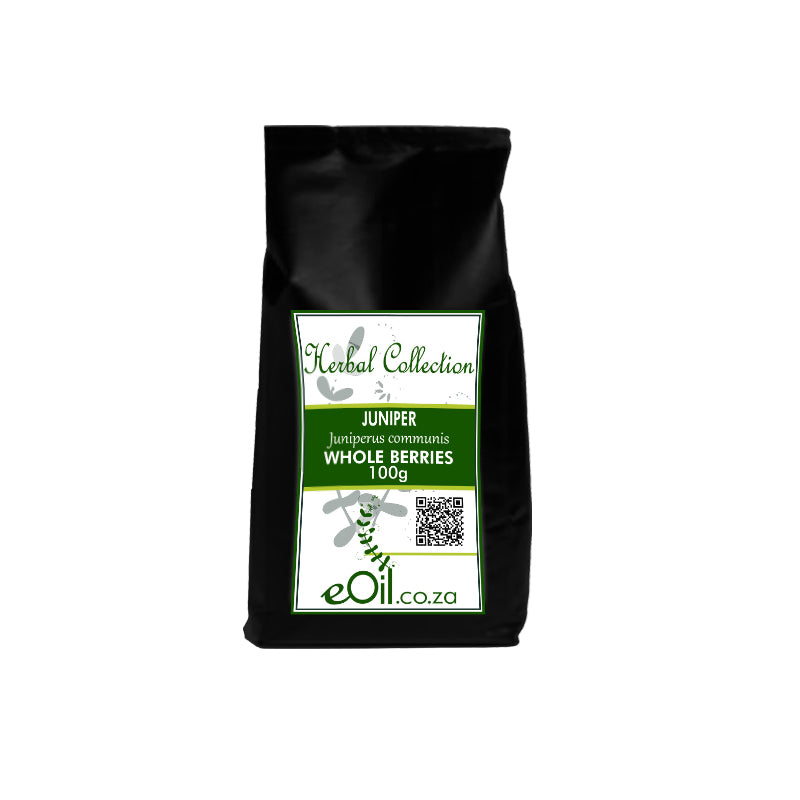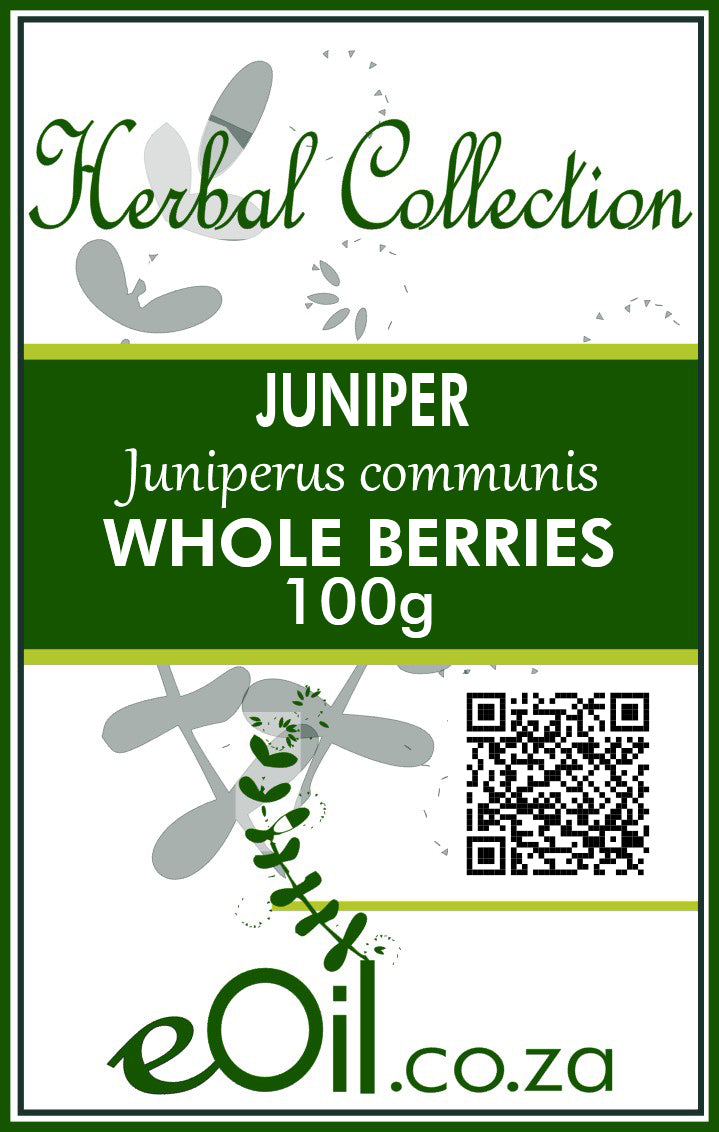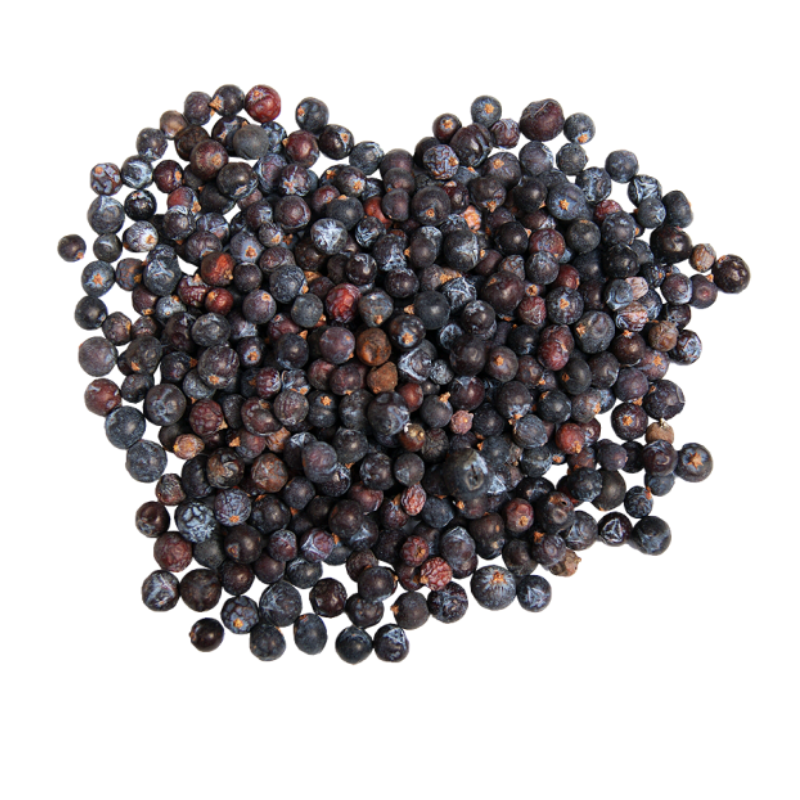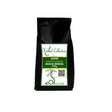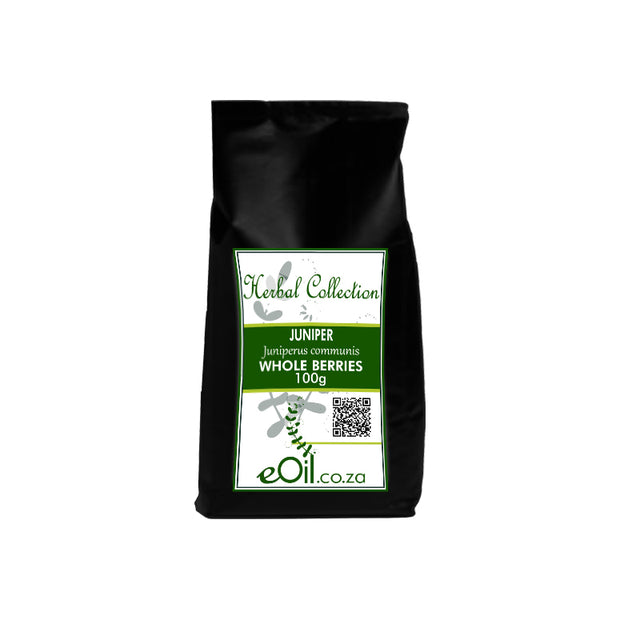Juniper Berries Dried - Herbal Collection
Juniper Berries Dried - Herbal Collection - 100 GR is backordered and will ship as soon as it is back in stock.
Description
Description
TRADITIONALLY USED FOR
- High in nutrients and powerful plant compounds.
- Provide anti-inflammatory and antioxidant effects.
- May have antidiabetic properties.
- Could promote heart health.
- Antibacterial and antifungal activity.
INFORMATION
Source : http://www.wikiphyto.org/wiki/Genevrier_commun
Reference on http://www.wikiphyto.org
Translation in English by Google Translate (go to the page of the source linked | on Chrome cellphones go on the 3 dots on the top right and select translate in your preferred language | on laptop right click your mouse and select option translate when hoovering on the page
plant name
Common Juniper, Juniper
International Latin denomination
Juniperus communis L. ssp communis
botanical family
Cupressaceae
Description and habitat
- Bushy shrub 1-6 m tall, widespread in mountainous regions, moors and clearings throughout the Northern Hemisphere
- Very narrow leaves, in whorls of three, ending in a sharp point
- Fruiting cones fleshy globose, 4-8 mm in diameter, first green then bluish-black and covered with wax when ripe
- We can find, on the same foot, green and black berries, they take three years to reach maturity.
History and tradition
- Thrown into the fire, the twigs were supposed to ward off evil spirits (use still attested in the monasteries of the Himalayas)
- It was also burned to ward off the plague
Parts used
Fruiting cones or “Juniper berries”, essential oil of twigs and berries
Dosage forms available
- Fruiting cone tincture
- Young growth glycerine macerate
- Essential oil of twigs and berries
Usual dosages
Composition
Main components of the plant
- Essential oil (1 to 2%) containing more than 60 components
- Tannins
- Flavonoids and biflavonoids : apigenin , rutin , luteolin , quercetin-3-O-arabinosyl-glucoside , quercetin-3-o-rhamnoside , quercitrin , scutellarein , nepetin , amentoflavone , bilobetin
- Proanthocyanidins
- Diterpenes ( junicedral )
- Bitter principle ( juniperine ), sugars, resin
Main components of buds or young shoots
Main components of essential oil
- Monoterpenes (up to 75%): myrcene (1-20%), sabinene (4-50%), alpha-pinene (10-70%), beta-pinene (1%), beta-phellandrene (1%) , delta-3-keel
- Alcohols: terpinene-4-ol (2%), cedrol (3%), elemol
- Sesquiterpenes : alaskene (2%), thujopsene = widdrene (33%), himachalene (3%), germacrene-B , germacrene-D , delta-cadinene , beta-caryophyllene
- The composition depends on the distilled organ (twigs, berries), and the distillation time which modifies the yield and the proportion of monoterpene hydrocarbons ( alpha-pinene and myrcene ), oxygenated monoterpenes and sesquiterpenes of the HE
Properties
Plant properties
- Validated properties: diuretic, anti-inflammatory [1] , [2] , antifungal, analgesic [3] , hepatoprotective [4] , antidiabetic, antihyperlipidemic, antibacterial [5] , antioxidant, antihypercholesterolemic [6] , neuroprotective in Parkinson's disease [7] , [8]
- Tonic, diuretic, antiseptic of the urinary tree, bacterial anti-adhesion [9]
- Facilitates drainage of the urinary tree, but should be avoided in renal insufficiency
- Stimulates the digestive system, the stomach, eliminates intestinal gas
- Antidiabetic [10] , [11] , by two modes of action:
- Increased peripheral glucose uptake
- Potentiation of glucose-induced insulin secretion [12]
- Anti-mycobacterial activity [13]
Bud properties
- Hepatotropic activity, hepatocellular regenerator [14]
- Detoxifying, anti-inflammatory
- Inhibits the formation of renal lithiasis (anti-lithiasis), renal protector, stimulation of renal drainage
- Tree resistant to cold and heat, it is indifferent to the nature of the soil. It is part of the mesoxerophilic vegetation of lawns and moors to make plants from the xerophilic calcicole pregrowth
Properties of essential oil
- Anti-inflammatory [15] and analgesic [16] , topical anti-inflammatory [17]
- Anti-putrid of the intestine in colitis (relation intestine - urinary tract)
- Inhibition of protein glycation, implication in the prevention of diabetes complications [18]
- Antioxidant activity and on acetylcholinesterase, by inhalation, potentialities in Alzheimer's disease [19]
- Antioxidant and anti-hypercholesterolemic activity [6] , potentialities in the prevention of atherosclerosis [20]
- Antifungal [21]
- Antimicrobial [22] , inhibits Mycobacterium tuberculosis [23]
- Juniperus procera EO is repellent to parasites (Rhipicephalus appendiculatus tick ) [ 24 ]
- Topically drains subcutaneous tissue
Directions
Indications of the whole plant (phytotherapy)
- Osteoarthritis and rheumatic diseases, chronic arthritis, gout
- Diabetes, hyperglycaemia
Indications of the bud (gemmotherapy)
- Hypercholesterolemia, hyperuricemia, high blood pressure, reduced risk of arteriosclerosis
- For Pol Henry: hepatocellular insufficiency, chronic persistent hepatitis, drug-induced and toxic hepatitis
- Hypertrophic alcoholic cirrhosis
- Portal hypertension
- Esophageal and gastric varices
- Beginning ascites
- Chronic pyelonephritis
- Alternate with Calluna vulgaris , calcium (oxalatic) nephrolithiasis
- Alternated with Berberis 3 x , recurrent hepatic colic
Complementary remedies:
- tree stratum
- Shrub layer
- Cytological and coagulation action
- Thrombophilic action
Specific indications of essential oil (aromatherapy)
- External use of essential oil: neuralgia and rheumatic pain
- Analgesic in neuritis, sciatica, arthritis
- Cellulitis (?)
Known or suspected mode of action
- Antidiabetic mode of action:
- Increased peripheral glucose uptake
- Potentiation of glucose-induced insulin secretion
- The delta-3-keel of a related species, Juniperus turbinata has a potent spectrum of activity against fungi
Usual formulations
Regulations
- French Pharmacopoeia list A (female cone called "juniper berry")
Possible side effects and precautions for use
- Avoid in case of pregnancy, heavy periods, renal insufficiency
- Caution: risk of albuminuria in overly prolonged cures
Bibliographic references
- Aller↑ Tunón H, Olavsdotter C, Bohlin L. Evaluation of anti-inflammatory activity of some Swedish medicinal plants. Inhibition of prostaglandin biosynthesis and PAF-induced exocytosis. J Ethnopharmacol. 1995 Oct;48(2):61-76. PMID 8583796
- Aller↑ Modnicki, Daniel & Łabędzka, Justyna. Estimation of the total phenolic compounds in juniper sprouts (Juniperus communis L., Cupressaceae) from different places at the kujawsko-pomorskie province. 55.Herba Polonica, vol. 55, no. 3, 2009.
- Aller↑ Banerjee, Saswata & Mukherjee, Antara & Chatterjee, Dr. (2012). Evaluation of Analgesic activities of methanolic extract of medicinal plant Juniperus communis Linn. International Journal of Pharmacy and Pharmaceutical Sciences. 4. 547-550.
- Aller↑ Manvi and GP Garg, “Screening and evaluation of pharmacognostic, phytochemical and hepatoprotective activity of J. communis L. Stems,” International Journal of Pharma and Bio Sciences, vol. 1, no. 3, 2010.
- Aller↑ Joshi, Savita & Sati, S C. (2010). Antibacterial potential of leaf extracts of Juniperus communis L. from Kumaun Himalaya. African journal of microbiology research. 4. 1291-1294.
- ↑ Aller à :6.0 and 6.1 Akdogan M, Koyu A, Ciris M, Yildiz K. Anti-hypercholesterolemic activity of Juniperus communis Lynn Oil in rats: A biochemical and histopathological investigation. Biomedical Research (2012) Volume 23, Issue 3
- Aller↑ Souravh Bais, Naresh Singh Gill, Nitan Rana, Shandeep Shandil. A Phytopharmacological Review on a Medicinal Plant: Juniperus communis. International Scholarly Research Notices Volume 2014, Article ID 634723, 6 pages http://dx.doi.org/10.1155/2014/634723
- Aller↑ Souravh Bais, NS Gill, Nitan Kumar. Neuroprotective Effect of Juniperus communis on Chlorpromazine Induced Parkinson Disease in Animal Model Chinese Journal of Biology, Volume 2015, Article ID 542542, 7 pages http://dx.doi.org/10.1155/2015/542542
- Aller↑ Yarnell E. Botanical medicines for the urinary tract. World J Urol. 2002 Nov;20(5):285-93. doi: 10.1007/s00345-002-0293-0. Epub 2002 Oct 17. PMID 12522584 .
- Aller↑ Swanston-Flatt SK, Day C, Bailey CJ, Flatt PR. Traditional plant treatments for diabetes. Studies in normal and streptozotocin diabetic mice. Diabetology. 1990 Aug;33(8):462-4. PMID 2210118
- Aller↑ Banerjee, Saswata & Singh, Hari & Chatterjee, Dr. (2013). Evaluation of anti-diabetic and anti-hyperlipidemic potential of methanolic extract of Juniperus Communis (L.) in streptozotocinnicotinamide induced diabetic rats. International Journal of Pharma and Bio Sciences. 4. 10-17.
- Aller↑ Sanchez de Medina F, Gamez MJ, Jimenez I, Jimenez J, Osuna JI, Zarzuelo A. Hypoglycemic activity of juniper "berries". PlantaMed. 1994 Jun;60(3):197-200. PMID 8073081
- Aller↑ Gordien AY, Gray AI, Franzblau SG, Seidel V. Antimycobacterial terpenoids from Juniperus communis L. (Cuppressaceae). J Ethnopharmacol. 2009 Dec 10;126(3):500-5. PMID 19755141
- Aller↑ Henry Pol. Gemmotherapy, therapy with plant embryonic extracts. Author's edition. Brussels, 1982.
- Aller↑ Han Xuesheng & Parker Tory. (2017). Anti-inflammatory activity of Juniper (Juniperus communis) berry essential oil in human dermal fibroblasts. Cogent Medicine. 4. 10.1080/2331205X.2017.1306200 full text
- Aller↑ Akkol EK, Güvenç A, Yesilada E. A comparative study on the antinociceptive and anti-inflammatory activities of five Juniperus taxa. J Ethnopharmacol. 2009 Sep 7;125(2):330-6. PMID 19505566
- Aller↑ Komeh-Nkrumah SA, Nanjundaiah SM, Rajaiah R, Yu H, Moudgil KD. Topical dermal application of essential oils attenuates the severity of adjuvant arthritis in Lewis rats. Phytotherapy Research. 2012;26(1):54-59. doi:10.1002/ptr.3509. Full Text
- Aller↑ Asgary S, Naderi GA, Shams Ardekani MR, Sahebkar A, Airin A, Aslani S, Kasher T, Emami SA. Inhibition of protein glycation by essential oils of branchlets and fruits of Juniperus communis subsp. hemisphaerica. Res Pharm Sci. 2014 May-Jun;9(3):179-85. PMID 25657787
- Aller↑ Cioanca O, Hancianu M, Mihasan M, Hritcu L. Anti-acetylcholinesterase and Antioxidant Activities of Inhaled Juniper Oil on Amyloid Beta (1-42)-Induced Oxidative Stress in the Rat Hippocampus. Neurochem Res. 2015 Mar 6. PMID 25743585
- Aller↑ Gumral N, Kumbul DD, Aylak F, Saygin M, Savik E. Juniperus communis Linn oil decreases oxidative stress and increases antioxidant enzymes in the heart of rats administered a diet rich in cholesterol. Toxicol Ind Health. 2015 Jan;31(1):85-91. doi: 10.1177/0748233712469995. PMID 23293127
- Aller↑ Moustafa A. Abbassy, Gehan I. Marei. Antifungal and Chemical Composition of Essential Oils of Juniperus communis L. and Thymus vulgaris L. against Two Phytopathogenic Fungi. Journal of Applied Sciences Research, 9(8): 4584-4588, 2013 ISSN 1819-544X
- Aller↑ Pepeljnjak, Stjepan & Kosalec, Ivan & Kalodera, Zdenka & Blazević, Nikola. (2006). Antimicrobial activity of juniper berry essential oil (Juniperus communis L., Cupressaceae). Acta pharmaceutica (Zagreb, Croatia). 55. 417-22.
- Aller↑ Cosentino S, Barra A, Pisano B, Cabizza M, Pirisi FM, Palmas F. Composition and antimicrobial properties of Sardinian Juniperus essential oils against foodborne pathogens and spoilage microorganisms. J Food Prot. 2003 Jul;66(7):1288-91.
- Aller↑ Wanzala W, Hassanali A, Mukabana WR, Takken W. Repellent Activities of Essential Oils of Some Plants Used Traditionally to Control the Brown Ear Tick, Rhipicephalus appendiculatus.J Parasitol Res. 2014;2014:434506. doi: 10.1155/2014/434506. PMID 24693417
- Final report on the safety assessment of Juniperus communis Extract, Juniperus oxycedrus Extract, Juniperus oxycedrus Tar, Juniperus phoenicea extract, and Juniperus virginiana Extract. Int J Toxicol. 2001;20 Suppl 2:41-56. PMID 11558640
- Jimenez-Arellanes A, Meckes M, Ramirez R, Torres J, Luna-Herrera J. Activity against multidrug-resistant Mycobacterium tuberculosis in Mexican plants used to treat respiratory diseases. Phytother Res. 2003 Sep;17(8):903-8.
- Mahfuz Elmastaş, İlhami Gülçin, Şükrü Beydemir, Ö. İrfan Küfrevioğlu, Hassan Y. Aboul-Enein. A Study on the In Vitro Antioxidant Activity of Juniper (Juniperus communis L.) Fruit Extracts. Analytical Letters, Volume 39, Issue 1, 2006
CAUTION
Store in a cool, dry place, away from light. Keep tightly closed, away from the reach of Children and pets.
Do not exceed the daily dose.
This product is not intended to prevent or cure any form of illness or disease.
If you are pregnant or nursing ; If you have a medical condition or are in the course of medical treatment ; If you are programmed for theater/operation in the near future, please consult your healthcare practitioner before using this product.
This product cannot replace a varied and balanced diet and a healthy lifestyle.
This product has not been evaluated by the SAHPRA for its quality, safety or intended use.
For More Information please check our General Safety Herbal products Page

Juniper Berries Dried - Herbal Collection - 100 GR is backordered and will ship as soon as it is back in stock.

